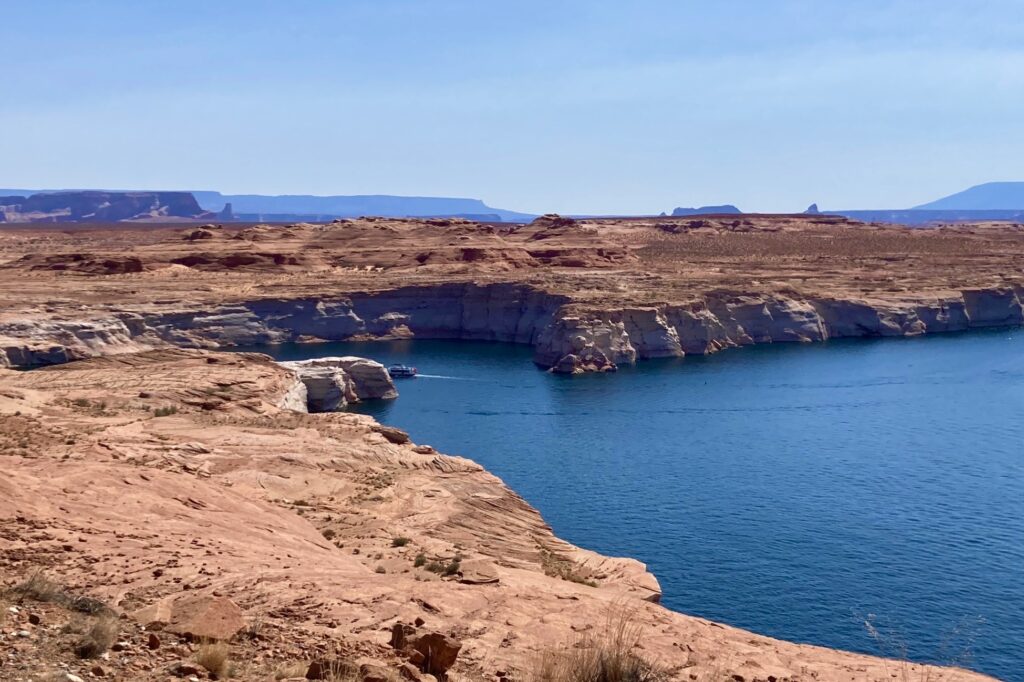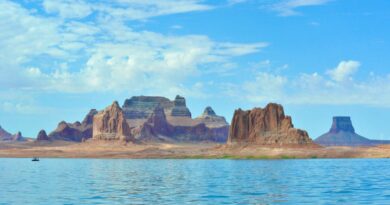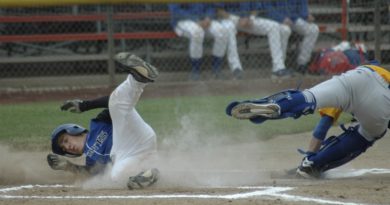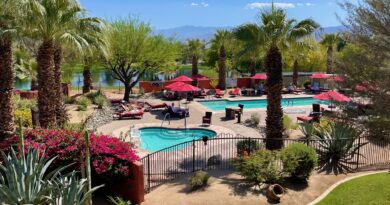A Lake Powell Adventure, Pt 1
A nine day houseboating adventure vacation on Lake Powell, which straddles the Arizona/Utah border, proved to be both. We had several wonderful relaxing days mixed with a few days of vigilance and care. In my experience that’s pretty typical of any boating vacation. It also took us two-plus days of driving just to get there and then get back home.
If you’re thinking of houseboating on a large lake reservoir, there are a surprising number of them available across the U.S. We enjoyed ours enough to want to get the rest of the family involved for a shot at Lake Roosevelt behind Grand Coulee Dam in Eastern Washington. And this time we won’t let anyone off the hook once they commit.
We’ve broken this adventure up into two parts. Part two will post next Tuesday. Read on for a glimpse of what lake houseboating is like in the great Southwest.
Day -2
Our fateful departure date has arrived. Packing kayaks on the GMC Yukon proves to be something of a project but by 9:30 we are on our way. Twelve hours later we arrive ready for rest in Twin Falls, ID. After 627 miles we are almost exactly halfway to our destination of Wahweap Marina near the southwestern end of Lake Powell, and just over the Utah/Arizona border.
Day -1
We finish our 530-mile, day 2 driving segment by stopping in the clean, cute little town of Kanab, UT, just north of the Arizona border and 75 miles from our Wahweap destination for gathering the houseboat. It turns out Kanab was a favored Hollywood film site for Westerns of the 40s through the early 70s. John Wayne, Maureen O’Hara, Gregory Peck, Barbara Stanwyck, Henry Fonda, the Rat Pack and many other famous actors made films here. We top off our evening with a stroll from our hotel to a favorite local eatery, the eclectic Rocking V Cafe. The place lives up to its humorous online billing with excellent food and friendly service. Our walk back includes stops to read numerous little information kiosks highlighting various actors and the movies they made in Kanab. Lots of fun.



Above, Left & Center – The Rocking V Cafe; Right – A John Wayne cutout greets you at the tourist information center
Day 1 – on the water June 28
It took two-plus long days of driving and most of a day houseboat cruising to find our spot. But now we’re here and it’s fantastic. We have a 50-foot houseboat and only three of us to crew it. I find myself wishing our boys had not bagged out on us. We’re all in our upper 60s and I’m the only guy. We’re all in good shape and have some boating experience, thank God, but this will probably be something of a challenge at times. I’ve been on and around boats since I was five, so fortunately I know enough to keep us safe.
Weaving and bobbing through narrow channels, dealing with one of two engines that’s constantly cutting out, having limited radio transmission capabilities, and listening to the operators patiently dealing with crazy loons on the ship to shore radio who have no clue what they’re doing dominated our first day here on Lake Powell.
Yes, there still is a Lake Powell, but barely. The water level is down some 100 or more feet from full, so many of the channels are now narrower with many more twists and turns. The channel buoys have moved and most times require a bit of interpolating to figure out where you really are. They have stopped releasing water from the lake in an attempt to raise water levels. It’s working, but no one knows how long that will last.
Our first day ends with us at the western end of Padre Bay and a lovely evening lounging in floaties with our favorite beverage and playing cards on the upper deck as the sun sets over our sand dune. Bed thankfully comes at 9 pm.

Day 2
Day breaks with a dead calm. A lone cricket has chirped most of the night. It’s just cool enough to be comfortable, a stark contrast to the radiant heat the houseboat released throughout the night. Around nine, the girls drop the kayaks and head northeast to search the far reaches of Padre Canyon. With historically low water levels, the lake isn’t what it’s been but there’s still a good time to be had.
Marine radio reception, especially transmission, can be intermittent, as line of sight FM doesn’t work particularly well in the now higher canyon walls. It’s somewhat humorous to listen to the chatter, as most people aren’t marine radio savvy. It runs the whole spectrum from lake veterans who know the protocol and the lake intimately, to those who have no idea in any respect. One wonders if they were paying any attention at all to the pre-sailing instructions.
Our port engine runs sporadically, possibly influenced by intermittent fuel starvation. The lake-roaming mechanic is supposed to visit us today and attempt a repair. The generator needs to be run 3-4 hours a day to recharge the inverter batteries, but only during cooler hours to avoid fuel vapor locks. Some people are running their generators all night for the air conditioning, meaning at 5 gallons per hour of fuel consumption they will exhaust their 200-gallon tank in a matter of only five or six days. When you’re on a boat, conservation of all things is key.
Our biggest confusion so far has been keeping the Utah and Arizona time zones straight. As Arizona doesn’t observe daylight savings, some devices are displaying Utah time while others are on Arizona time. It’s easy to lose track which is which.
While the girls are out on their kayak adventure, I set about tidying up the crew-side of the boat by properly stowing lines and re-setting anchors. Anchor setting on Lake Powell is a different animal than the Puget Sound inland salt waters I’m used to. Anchoring here is set on-shore, and there are four, yes four, anchors required! There is no anchoring on the water – it’s simply too deep. One must find a suitable spot by looking for a relatively steep, sandy embankment and beach the boat bow in. With all the sandstone formations here, finding a sandy spot is harder than one might think.
After beaching late Tuesday afternoon, I didn’t feel like properly setting all four in the afternoon heat. But I do put them out and set them at angles to the boat, tying them off to the bow and stern on each side. It’s a makeshift setup, so today I need to do them correctly. While the weather looks benign enough now, it can turn quickly and I feel the need to be prepared. Once the winds start it will be too late to stop bad things from happening.
The proper procedure is to dig 2-3 foot deep holes to drop, set and bury the anchors in, to tie them off at the stern, and set two per side at 45 and 60 degrees to the hull. It’s not something you want to go through every day, so like most of the boats out here you find a spot and stay put for a few days.
I ask these questions and others before we set sail, like hull draft, engine hourly fuel consumption and most efficient RPMs to run. One wonders what all these first-time boaters do here without knowing the right questions to ask. That question is answered by listening to the marine band reserved for our boat rental service – it’s always full of people with questions and problems asking for help. That’s where our one mechanic who spends his days running about the lake servicing many of those issues comes in.
Weather challenges arrive late in the afternoon. The thunderstorms we’ve been seeing around us all day are drawing closer, and a squall warns of its arrival with a swift and brisk increase in winds. We have been enjoying a float on the water, but as the wind comes up, I suggest we best head back to the boat. We don’t want to get swept off, which is entirely possible. It turns out to be a well-heeded thought as the winds keep increasing. Later, we find out earlier in the week a few people had been swept a couple miles from their houseboat when winds took them. You must be smart out here and always plan for unfavorable outcomes.
Our erstwhile on-lake mechanic suddenly makes an appearance as the winds come up. He’s checking on everyone to make sure they’re properly dug in. The boat a quarter-mile up the shore from us did not follow his anchoring warnings from the day before, and now they have blown sideways and are nearly fully beached. He sets about pulling them off and getting them to properly set the boat. Then he heads our way to check our anchoring and troubleshoot our intermittent-running port engine. The engine seems to need a software update and/or a flash reset of its main computer. So, we’ll have to make due until we return to port. Not a big issue at this point. If it gets worse, we’ll be seeing him again.
He helps with some advice on re-locating a couple anchors. More digging and line setting. It’s still 95 degrees, so this gets the sweat going. Between the anchors and motor testing, he’s here for about 40 minutes. Naturally, we engage in conversation. We find out he works from about 8am to 9pm, 5-6 days a week. That’s a break from his previous job which was as much as 100 hours or more a week. He’s almost done putting his wife through radiology school. Old age and cynicism make us wonder if she’s using him. Before he heads out, we get remined again as we did before setting sail, “This is not a vacation! This is an adventure – stay prepared!”
Anchors properly set, my work is finally done. Everything’s stowed and battened down. It turns out the night is relatively calm, but day three promises the threat of more thunderstorms and increasing wind.
Day 3
Morning is calm and quiet with high clouds and overcast. Thunderstorms are still in the area. The breeze picks up now and then, seemingly to remind us anything can happen quickly. Things continue mellow though for most of the day. Reading, kayaking, floating about, and finally getting a chance to fully relax is a welcome break from the maintenance routine. Afternoon brings three wandering teenage girls on skidoos. Seems they’ve spotted our boat’s twisting water slide. Their fearless leader asks if they could see what it’s like, just once? How can we not say yes? They’re polite, cute, and just out enjoying the water. Each of them gives the slide a go; two even go twice. Then, it’s a thank you for being so nice and an exclamation that was sure fun! Then they’re off again. Simple, direct, easy, fun. Doesn’t get much better than that.
Close to sunset another squall threatens with rising winds and blowing sand. The boat is secure, but we scramble to close windows. Then it’s an evening of cards and me getting thrashed once again at canasta. These women have no mercy.
Day 4
Today we’re going to look for a new anchor spot. Mid-morning we break anchor and head for Kane Canyon. I want to find something and be all set before the late afternoon winds and weather have a chance to catch us unprepared. And then there are the weekenders and the July fourther’s. I figure it’s going to be a crowed and noisy next three days.
After a couple times back and forth up and down the east shoreline of Kane Canyon and Padre Bay, we end up in a cove at the southeast end of Padre near Kimball Point and directly south of Cookie Jar, a sandstone monument that resembles, guess what, a cookie jar with a lid. Our first choice from earlier is now taken, so we find something suitable further still into the canyon.
As we’re docking, a breeze comes up I hadn’t planned on. On boats, something unplanned doesn’t usually turn out well, and this is no exception. Houseboats are like sails. With their huge slab sides, any wind can push them sideways or off target. I’m already on the beach digging the first anchor hole when the ladies yell at me. I look up to see the boat about to be beached starboard side by the wind. I drop the shovel, run to the bow, stow the gangplank, jump the four feet up to get on board, and man the helm. Start engines and gun the port engine into reverse. Then I turn the wheel and gun the starboard engine into reverse.
These boats never respond immediately to input and inertia is a big deal on a boat – there’s a lot of weight and momentum here; you don’t do anything without having to plan and account for it. Imagine driving a car without brakes, it’s something like that.
We get lucky and I manage to pull us back from disaster. Not parking here. Bad mojo. I pull back, give myself some room and spin the boat around to exit this narrow finger. We motor back out into the main part of the cove and find another spot recently vacated by another boat. It’s a little more exposed to wave action, but in a nice mini-cove. This time we heave to and prep all four anchor lines prior to nosing in. I have a line and an anchor in hand when I hit the sand off the bow.
Fairly decent anchor holes are still here from the previous boat. We’ll use those in a few minutes. First, I position myself for the first windward anchor, drop it and pull the slack out of the line that’s already cleated to the starboard stern. I just stand there and slowly arrest the boat’s leeward movement. Then, I start to pull to bring it back to perpendicular to the shore. Once I’ve got this 50-foot behemoth moving the right way, I temporarily set the anchor at about 45 degrees from the boat, run the line through the clevis and tie it off with a quick looped square knot.
It’s when I look up that I notice two lonely, abandoned toy trucks sitting on a rock a few feet away. I think of the boat here before us and wonder if the lads are aware of their loss yet. I sympathize with them as I briefly recall our boys’ losing toys on trips and the disappointment that always followed. But now it’s on to the second starboard anchor!
Sheryl hands me the second anchor and I dig a new hole at a more acute angle to the boat. Lots of rocks to contend with, but I’ve already broken a sweat, so whatever. Janice tosses me the second line and I tie it off with a bowline. Janice then pulls the slack out of it from the stern and cleats it with a figure 8. Once she’s done, I go back to the first anchor, dig a proper hole, release the line and reset the anchor. Then, I tie the end of that line off to the anchor also using a bowline. Janice then pulls the slack out of the first line and re-cleats it.
If you’re going to be a proper boatsman, you should probably learn how to tie a bowline knot. It’s relatively fast, it’s versatile and compared to most other knots comes apart easily even after being loaded.
Now that the windward anchors are secure, we repeat the process and set both port side, leeward anchors. Once back onboard, I reset the lines to make them as tight as I can. One person typically can’t take every bit of slack out of four different lines like that, and some movement between them is good so there’s a little give and take.
Finally, the work is done. After about 30 minutes of this I’m covered in sweat. I dive off the swimstep and am instantly refreshed. The water’s about 70 degrees. Janice and Sheryl ply me with a floatie and a vodka tonic for my reward. All is good again.
We do have a little drama about 4:45 when the generator quits. I let it sit for a few minutes, reset the circuit breaker and try again. Nothing. I try to raise the marina on the radio, but we have no transmitting reception. Luckily, we do have some cell reception, so we call the houseboat company’s repair shop. He helps me clear the error codes and reset the generator. It starts on the first try. Yeah! Now I can relax again.
Day 5
This is going to be a busy day. About 6:30am I reset the lines again to try and minimize some of the bouncing that will come later with all the wave action. The morning is a bit cooler than previous days, and for us Northwesterners, that means more comfortable. It’ll warm up soon enough. Going from what so far has been a very cool summer in the Pacific Northwest (barely reaching 70) this is a bit of climate shock. Today it reached 98 on the water; tomorrow promises triple digits.
Lots of water traffic; wake boarding and surfing, cigarette boat cruising, skidoos galore, even some fishing. There are some good-sized fish, like in the 15 – 30 pound range, in this lake. We see plenty of what look like catfish jumping when we’re moving about on the water.
All that activity makes for lots of wave action, so our boat is constantly exercising the four anchor lines. Every day I reset them, as the water level may have changed or the wind may have shifted or slackened. Early morning’s the best time because it’s usually calm and any slack will show up then.
A 7am Kayak sojourn has become something of a ritual with Janice and Sheryl. They could be gone anywhere from one to three hours, just casually exploring the area. When full, this is a 200-mile long lake with nearly 1,900 miles of shoreline, so there’s plenty to see. And it is beautiful. Sandstone makes a great shaping medium for Mother Nature, and she does her work spectacularly well. Large scale monuments with colorful names like Gun Sight, Castle Rock and Cookie Jar dot the landscape with creeks and canyons, like Labyrinth and Antelope, seemingly forming every nook and cranny in this once mighty Colorado River canyon now filled with reservoir by the building of the Glen Canyon Dam back in 1964. I’ve never seen green tumbleweeds before or encountered their prickly little spines, but there’s plenty of them here. The wind also gathers their brown brethren in groups around the lake as well.
I have settled into the habit of running the generator for a couple hours in the morning and again around 9pm. This works well to control fuel consumption while managing the air conditioner and inverter voltage levels. It doesn’t work so well when the generator decides to cut out at 10:30 in the pitch black with another error code. I’m too tired to go fumble around in the dark down in the hold. I leave the error codes to themselves for the night. Hopefully, we can figure it out in the morning.
Next Tuesday, Part 2.




